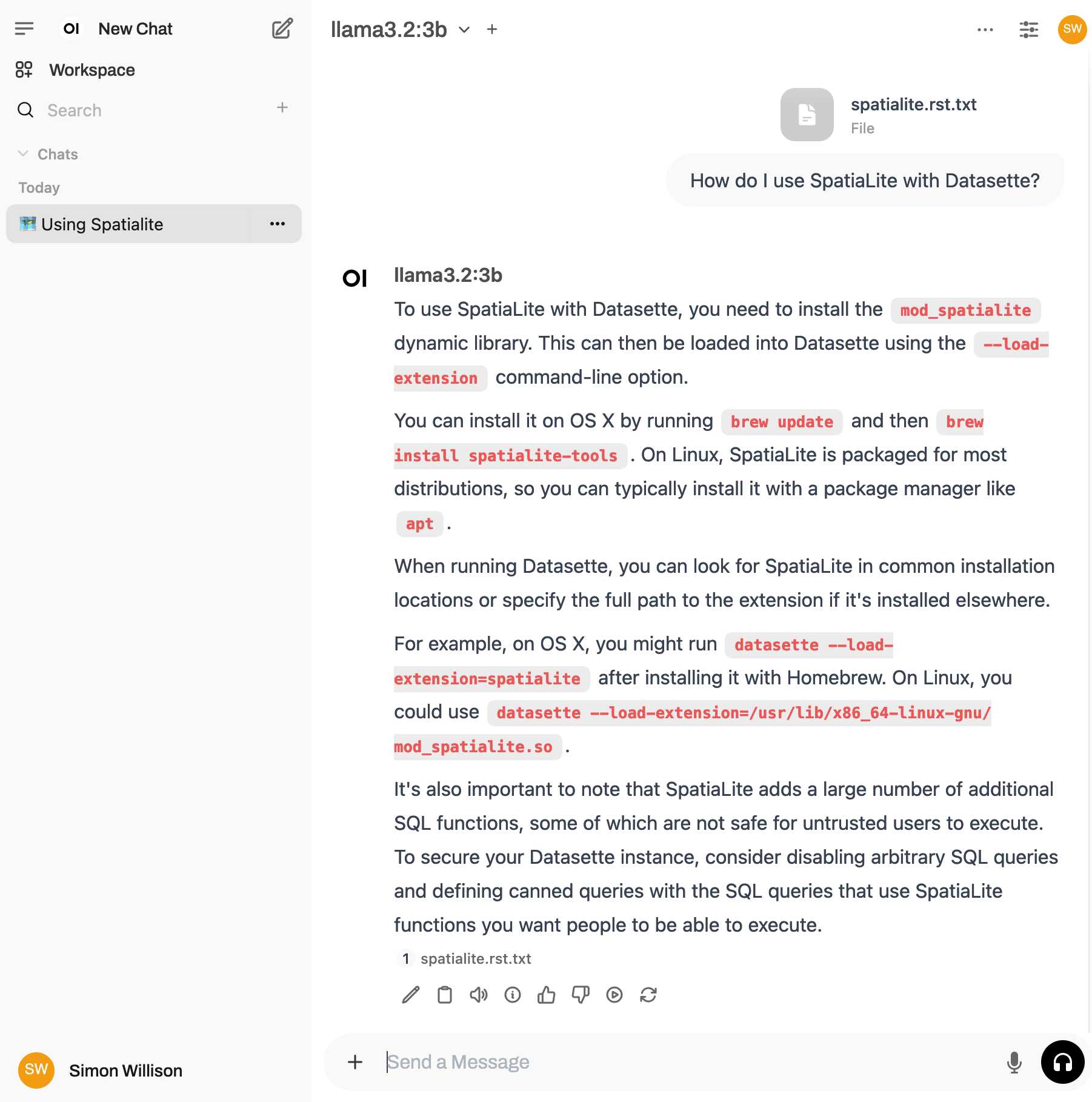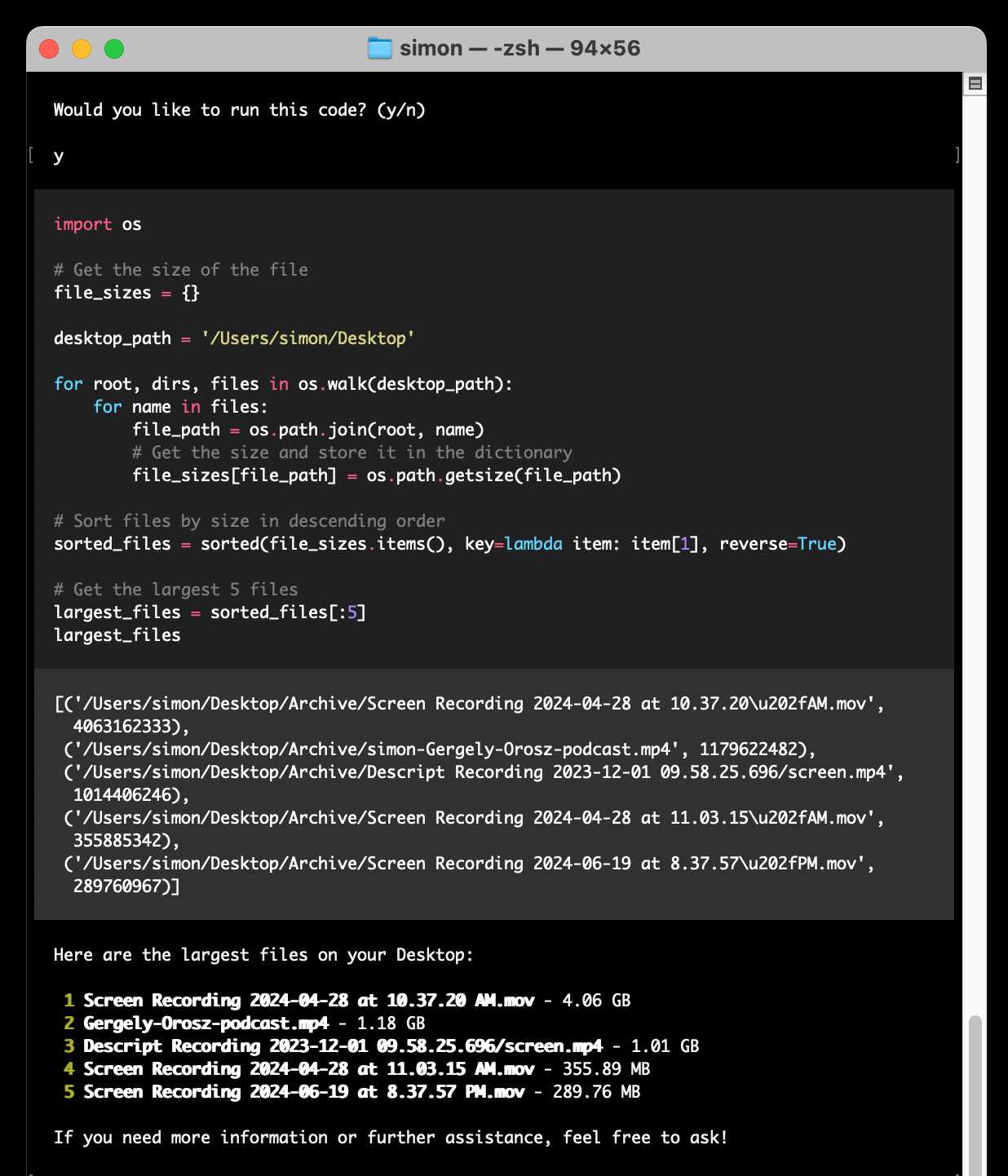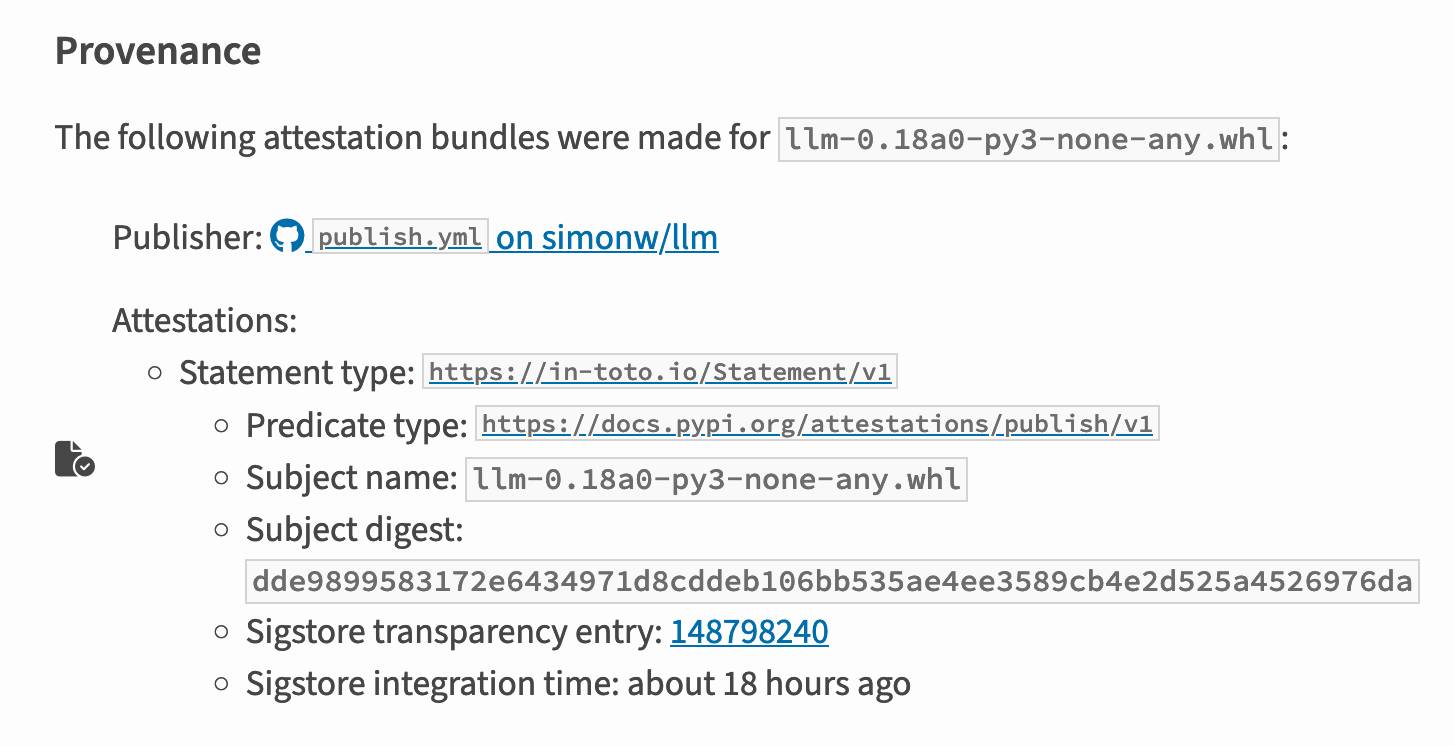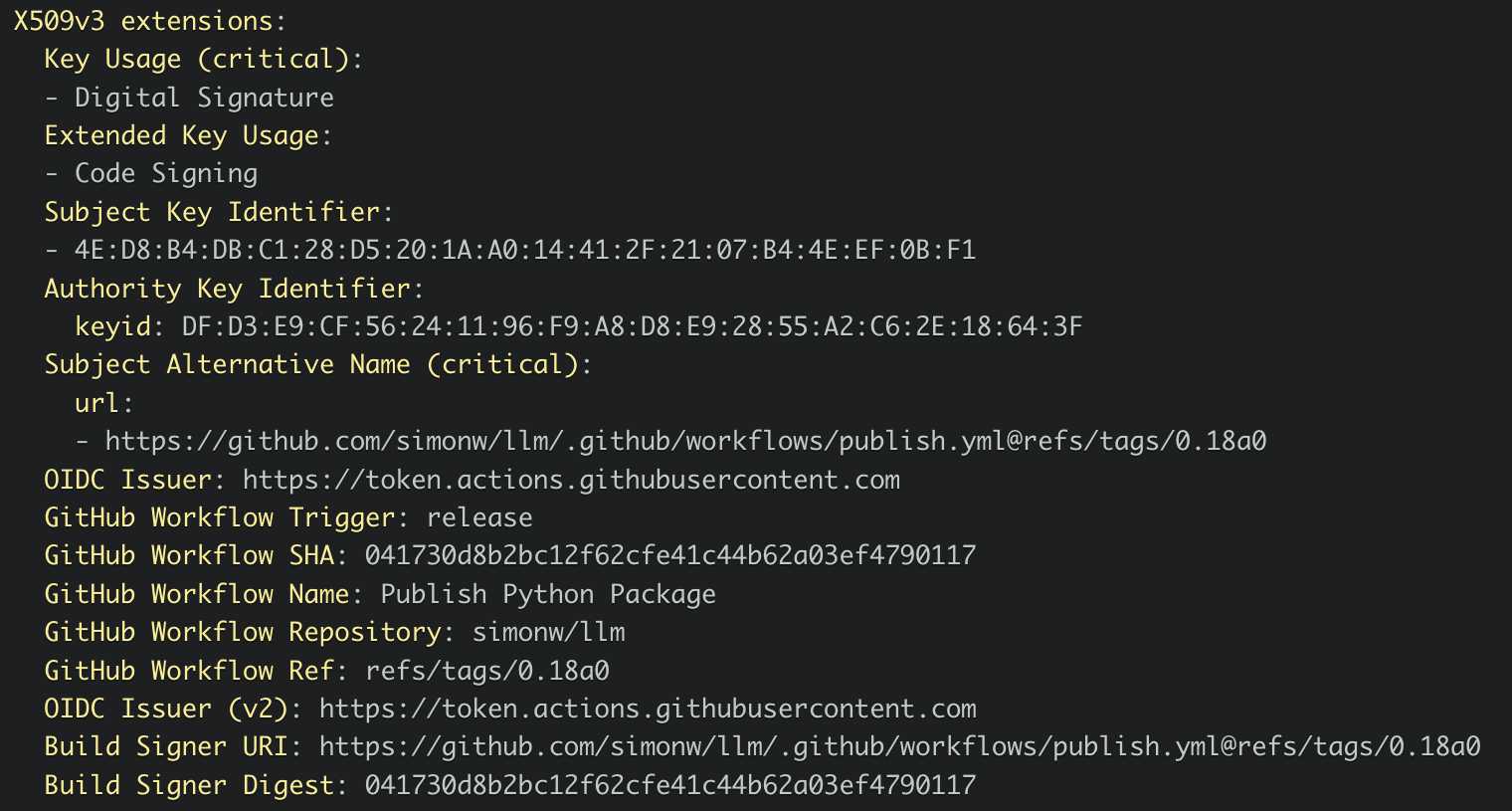1,211 posts tagged “python”
The Python programming language.
2025
Latest black (25.1.0) adds a newline after docstring and before pass in an exception class.
I filed a bug report against Black when the latest release - 25.1.0 - reformatted the following code to add an ugly (to me) newline between the docstring and the pass:
class ModelError(Exception): "Models can raise this error, which will be displayed to the user" pass
Black maintainer Jelle Zijlstra confirmed that this is intended behavior with respect to Black's 2025 stable style, but also helped me understand that the pass there is actually unnecessary so I can fix the aesthetics by removing that entirely.
I'm linking to this issue because it's a neat example of how I like to include steps-to-reproduce using uvx to create one-liners you can paste into a terminal to see the bug that I'm reporting. In this case I shared the following:
Here's a way to see that happen using
uvx. With the previous Black version:echo 'class ModelError(Exception): "Models can raise this error, which will be displayed to the user" pass' | uvx --with 'black==24.10.0' black -This outputs:
class ModelError(Exception): "Models can raise this error, which will be displayed to the user" pass All done! ✨ 🍰 ✨ 1 file left unchanged.But if you bump to
25.1.0this happens:echo 'class ModelError(Exception): "Models can raise this error, which will be displayed to the user" pass' | uvx --with 'black==25.1.0' black -Output:
class ModelError(Exception): "Models can raise this error, which will be displayed to the user" pass reformatted - All done! ✨ 🍰 ✨ 1 file reformatted.
Via David Szotten I learned that you can use uvx black@25.1.0 here instead.
The surprising way to save memory with BytesIO
(via)
Itamar Turner-Trauring explains that if you have a BytesIO object in Python calling .read() on it will create a full copy of that object, doubling the amount of memory used - but calling .getvalue() returns a bytes object that uses no additional memory, instead using copy-on-write.
.getbuffer() is another memory-efficient option but it returns a memoryview which has less methods than the bytes you get back from .getvalue()- it doesn't have .find() for example.
PyPI now supports project archival. Neat new PyPI feature, similar to GitHub's archiving repositories feature. You can now mark a PyPI project as "archived", making it clear that no new releases are planned (though you can switch back out of that mode later if you need to).
I like the sound of these future plans around this topic:
Project archival is the first step in a larger project, aimed at improving the lifecycle of projects on PyPI. That project includes evaluating additional project statuses (things like "deprecated" and "unmaintained"), as well as changes to PyPI's public APIs that will enable clients to retrieve and act on project status information. You can track our progress on these fronts by following along with warehouse#16844!
We’re building a new static type checker for Python, from scratch, in Rust. From a technical perspective, it’s probably our most ambitious project yet. We’re about 800 PRs deep!
Like Ruff and uv, there will be a significant focus on performance. The entire system is designed to be highly incremental so that it can eventually power a language server (e.g., only re-analyze affected files on code change). [...]
We haven't publicized it to-date, but all of this work has been happening in the open, in the Ruff repository.
A selfish personal argument for releasing code as Open Source
I’m the guest for the most recent episode of the Real Python podcast with Christopher Bailey, talking about Using LLMs for Python Development. We covered a lot of other topics as well—most notably my relationship with Open Source development over the years.
[... 464 words]uv python install --reinstall 3.13.
I couldn't figure out how to upgrade the version of Python 3.13 I had previous installed using uv - I had Python 3.13.0.rc2. Thanks to Charlie Marsh I learned the command for upgrading to the latest uv-supported release:
uv python install --reinstall 3.13
I can confirm it worked using:
uv run --python 3.13 python -c 'import sys; print(sys.version)'
Caveat from Zanie Blue on my PR to document this:
There are some caveats we'd need to document here, like this will break existing tool installations (and other virtual environments) that depend on the version. You'd be better off doing
uv python install 3.13.Xto add the new patch version in addition to the existing one.
Can LLMs write better code if you keep asking them to “write better code”?
(via)
Really fun exploration by Max Woolf, who started with a prompt requesting a medium-complexity Python challenge - "Given a list of 1 million random integers between 1 and 100,000, find the difference between the smallest and the largest numbers whose digits sum up to 30" - and then continually replied with "write better code" to see what happened.
It works! Kind of... it's not quite as simple as "each time round you get better code" - the improvements sometimes introduced new bugs and often leaned into more verbose enterprisey patterns - but the model (Claude in this case) did start digging into optimizations like numpy and numba JIT compilation to speed things up.
I used to find the thing where telling an LLM to "do better" worked completely surprising. I've since come to terms with why it works: LLMs are effectively stateless, so each prompt you execute is considered as an entirely new problem. When you say "write better code" your prompt is accompanied with a copy of the previous conversation, so you're effectively saying "here is some code, suggest ways to improve it". The fact that the LLM itself wrote the previous code isn't really important.
I've been having a lot of fun recently using LLMs for cooking inspiration. "Give me a recipe for guacamole", then "make it tastier" repeated a few times results in some bizarre and fun variations on the theme!
2024
Open WebUI. I tried out this open source (MIT licensed, JavaScript and Python) localhost UI for accessing LLMs today for the first time. It's very nicely done.
I ran it with uvx like this:
uvx --python 3.11 open-webui serve
On first launch it installed a bunch of dependencies and then downloaded 903MB to ~/.cache/huggingface/hub/models--sentence-transformers--all-MiniLM-L6-v2 - a copy of the all-MiniLM-L6-v2 embedding model, presumably for its RAG feature.
It then presented me with a working Llama 3.2:3b chat interface, which surprised me because I hadn't spotted it downloading that model. It turns out that was because I have Ollama running on my laptop already (with several models, including Llama 3.2:3b, already installed) - and Open WebUI automatically detected Ollama and gave me access to a list of available models.
I found a "knowledge" section and added all of the Datasette documentation (by dropping in the .rst files from the docs) - and now I can type # in chat to search for a file, add that to the context and then ask questions about it directly.
I selected the spatialite.rst.txt file, prompted it with "How do I use SpatiaLite with Datasette" and got back this:

That's honestly a very solid answer, especially considering the Llama 3.2 3B model from Ollama is just a 1.9GB file! It's impressive how well that model can handle basic Q&A and summarization against text provided to it - it somehow has a 128,000 token context size.
Open WebUI has a lot of other tricks up its sleeve: it can talk to API models such as OpenAI directly, has optional integrations with web search and custom tools and logs every interaction to a SQLite database. It also comes with extensive documentation.
Trying out QvQ—Qwen’s new visual reasoning model
I thought we were done for major model releases in 2024, but apparently not: Alibaba’s Qwen team just dropped the Apache 2.0 licensed Qwen licensed (the license changed) QvQ-72B-Preview, “an experimental research model focusing on enhancing visual reasoning capabilities”.
Finally, a replacement for BERT: Introducing ModernBERT (via) BERT was an early language model released by Google in October 2018. Unlike modern LLMs it wasn't designed for generating text. BERT was trained for masked token prediction and was generally applied to problems like Named Entity Recognition or Sentiment Analysis. BERT also wasn't very useful on its own - most applications required you to fine-tune a model on top of it.
In exploring BERT I decided to try out dslim/distilbert-NER, a popular Named Entity Recognition model fine-tuned on top of DistilBERT (a smaller distilled version of the original BERT model). Here are my notes on running that using uv run.
Jeremy Howard's Answer.AI research group, LightOn and friends supported the development of ModernBERT, a brand new BERT-style model that applies many enhancements from the past six years of advances in this space.
While BERT was trained on 3.3 billion tokens, producing 110 million and 340 million parameter models, ModernBERT trained on 2 trillion tokens, resulting in 140 million and 395 million parameter models. The parameter count hasn't increased much because it's designed to run on lower-end hardware. It has a 8192 token context length, a significant improvement on BERT's 512.
I was able to run one of the demos from the announcement post using uv run like this (I'm not sure why I had to use numpy<2.0 but without that I got an error about cannot import name 'ComplexWarning' from 'numpy.core.numeric'):
uv run --with 'numpy<2.0' --with torch --with 'git+https://github.com/huggingface/transformers.git' pythonThen this Python:
import torch from transformers import pipeline from pprint import pprint pipe = pipeline( "fill-mask", model="answerdotai/ModernBERT-base", torch_dtype=torch.bfloat16, ) input_text = "He walked to the [MASK]." results = pipe(input_text) pprint(results)
Which downloaded 573MB to ~/.cache/huggingface/hub/models--answerdotai--ModernBERT-base and output:
[{'score': 0.11669921875,
'sequence': 'He walked to the door.',
'token': 3369,
'token_str': ' door'},
{'score': 0.037841796875,
'sequence': 'He walked to the office.',
'token': 3906,
'token_str': ' office'},
{'score': 0.0277099609375,
'sequence': 'He walked to the library.',
'token': 6335,
'token_str': ' library'},
{'score': 0.0216064453125,
'sequence': 'He walked to the gate.',
'token': 7394,
'token_str': ' gate'},
{'score': 0.020263671875,
'sequence': 'He walked to the window.',
'token': 3497,
'token_str': ' window'}]
I'm looking forward to trying out models that use ModernBERT as their base. The model release is accompanied by a paper (Smarter, Better, Faster, Longer: A Modern Bidirectional Encoder for Fast, Memory Efficient, and Long Context Finetuning and Inference) and new documentation for using it with the Transformers library.
Building Python tools with a one-shot prompt using uv run and Claude Projects
I’ve written a lot about how I’ve been using Claude to build one-shot HTML+JavaScript applications via Claude Artifacts. I recently started using a similar pattern to create one-shot Python utilities, using a custom Claude Project combined with the dependency management capabilities of uv.
[... 899 words]Phi-4 Technical Report (via) Phi-4 is the latest LLM from Microsoft Research. It has 14B parameters and claims to be a big leap forward in the overall Phi series. From Introducing Phi-4: Microsoft’s Newest Small Language Model Specializing in Complex Reasoning:
Phi-4 outperforms comparable and larger models on math related reasoning due to advancements throughout the processes, including the use of high-quality synthetic datasets, curation of high-quality organic data, and post-training innovations. Phi-4 continues to push the frontier of size vs quality.
The model is currently available via Azure AI Foundry. I couldn't figure out how to access it there, but Microsoft are planning to release it via Hugging Face in the next few days. It's not yet clear what license they'll use - hopefully MIT, as used by the previous models in the series.
In the meantime, unofficial GGUF versions have shown up on Hugging Face already. I got one of the matteogeniaccio/phi-4 GGUFs working with my LLM tool and llm-gguf plugin like this:
llm install llm-gguf
llm gguf download-model https://huggingface.co/matteogeniaccio/phi-4/resolve/main/phi-4-Q4_K_M.gguf
llm chat -m gguf/phi-4-Q4_K_M
This downloaded a 8.4GB model file. Here are some initial logged transcripts I gathered from playing around with the model.
An interesting detail I spotted on the Azure AI Foundry page is this:
Limited Scope for Code: Majority of phi-4 training data is based in Python and uses common packages such as
typing,math,random,collections,datetime,itertools. If the model generates Python scripts that utilize other packages or scripts in other languages, we strongly recommend users manually verify all API uses.
This leads into the most interesting thing about this model: the way it was trained on synthetic data. The technical report has a lot of detail about this, including this note about why synthetic data can provide better guidance to a model:
Synthetic data as a substantial component of pretraining is becoming increasingly common, and the Phi series of models has consistently emphasized the importance of synthetic data. Rather than serving as a cheap substitute for organic data, synthetic data has several direct advantages over organic data.
Structured and Gradual Learning. In organic datasets, the relationship between tokens is often complex and indirect. Many reasoning steps may be required to connect the current token to the next, making it challenging for the model to learn effectively from next-token prediction. By contrast, each token generated by a language model is by definition predicted by the preceding tokens, making it easier for a model to follow the resulting reasoning patterns.
And this section about their approach for generating that data:
Our approach to generating synthetic data for phi-4 is guided by the following principles:
- Diversity: The data should comprehensively cover subtopics and skills within each domain. This requires curating diverse seeds from organic sources.
- Nuance and Complexity: Effective training requires nuanced, non-trivial examples that reflect the complexity and the richness of the domain. Data must go beyond basics to include edge cases and advanced examples.
- Accuracy: Code should execute correctly, proofs should be valid, and explanations should adhere to established knowledge, etc.
- Chain-of-Thought: Data should encourage systematic reasoning, teaching the model various approaches to the problems in a step-by-step manner. [...]
We created 50 broad types of synthetic datasets, each one relying on a different set of seeds and different multi-stage prompting procedure, spanning an array of topics, skills, and natures of interaction, accumulating to a total of about 400B unweighted tokens. [...]
Question Datasets: A large set of questions was collected from websites, forums, and Q&A platforms. These questions were then filtered using a plurality-based technique to balance difficulty. Specifically, we generated multiple independent answers for each question and applied majority voting to assess the consistency of responses. We discarded questions where all answers agreed (indicating the question was too easy) or where answers were entirely inconsistent (indicating the question was too difficult or ambiguous). [...]
Creating Question-Answer pairs from Diverse Sources: Another technique we use for seed curation involves leveraging language models to extract question-answer pairs from organic sources such as books, scientific papers, and code.
googleapis/python-genai. Google released this brand new Python library for accessing their generative AI models yesterday, offering an alternative to their existing generative-ai-python library.
The API design looks very solid to me, and it includes both sync and async implementations. Here's an async streaming response:
async for response in client.aio.models.generate_content_stream(
model='gemini-2.0-flash-exp',
contents='Tell me a story in 300 words.'
):
print(response.text)
It also includes Pydantic-based output schema support and some nice syntactic sugar for defining tools using Python functions.
ChatGPT Canvas can make API requests now, but it’s complicated
Today’s 12 Days of OpenAI release concerned ChatGPT Canvas, a new ChatGPT feature that enables ChatGPT to pop open a side panel with a shared editor in it where you can collaborate with ChatGPT on editing a document or writing code.
[... 1,116 words]Introducing Limbo: A complete rewrite of SQLite in Rust (via) This looks absurdly ambitious:
Our goal is to build a reimplementation of SQLite from scratch, fully compatible at the language and file format level, with the same or higher reliability SQLite is known for, but with full memory safety and on a new, modern architecture.
The Turso team behind it have been maintaining their libSQL fork for two years now, so they're well equipped to take on a challenge of this magnitude.
SQLite is justifiably famous for its meticulous approach to testing. Limbo plans to take an entirely different approach based on "Deterministic Simulation Testing" - a modern technique pioneered by FoundationDB and now spearheaded by Antithesis, the company Turso have been working with on their previous testing projects.
Another bold claim (emphasis mine):
We have both added DST facilities to the core of the database, and partnered with Antithesis to achieve a level of reliability in the database that lives up to SQLite’s reputation.
[...] With DST, we believe we can achieve an even higher degree of robustness than SQLite, since it is easier to simulate unlikely scenarios in a simulator, test years of execution with different event orderings, and upon finding issues, reproduce them 100% reliably.
The two most interesting features that Limbo is planning to offer are first-party WASM support and fully asynchronous I/O:
SQLite itself has a synchronous interface, meaning driver authors who want asynchronous behavior need to have the extra complication of using helper threads. Because SQLite queries tend to be fast, since no network round trips are involved, a lot of those drivers just settle for a synchronous interface. [...]
Limbo is designed to be asynchronous from the ground up. It extends
sqlite3_step, the main entry point API to SQLite, to be asynchronous, allowing it to return to the caller if data is not ready to consume immediately.
Datasette provides an async API for executing SQLite queries which is backed by all manner of complex thread management - I would be very interested in a native asyncio Python library for talking to SQLite database files.
I successfully tried out Limbo's Python bindings against a demo SQLite test database using uv like this:
uv run --with pylimbo python
>>> import limbo
>>> conn = limbo.connect("/tmp/demo.db")
>>> cursor = conn.cursor()
>>> print(cursor.execute("select * from foo").fetchall())
It crashed when I tried against a more complex SQLite database that included SQLite FTS tables.
The Python bindings aren't yet documented, so I piped them through LLM and had the new google-exp-1206 model write this initial documentation for me:
files-to-prompt limbo/bindings/python -c | llm -m gemini-exp-1206 -s 'write extensive usage documentation in markdown, including realistic usage examples'
I can now run a GPT-4 class model on my laptop
Meta’s new Llama 3.3 70B is a genuinely GPT-4 class Large Language Model that runs on my laptop.
[... 2,905 words]Transferring Python Build Standalone Stewardship to Astral. Gregory Szorc's Python Standalone Builds have been quietly running an increasing portion of the Python ecosystem for a few years now, but really accelerated in importance when uv started using them for new Python installations managed by that tool. The releases (shipped via GitHub) have now been downloaded over 70 million times, 50 million of those since uv's initial release in March of this year.
uv maintainers Astral have been helping out with PSB maintenance for a while:
When I told Charlie I could use assistance supporting PBS, Astral employees started contributing to the project. They have built out various functionality, including Python 3.13 support (including free-threaded builds), turnkey automated release publishing, and debug symbol stripped builds to further reduce the download/install size. Multiple Astral employees now have GitHub permissions to approve/merge PRs and publish releases. All releases since April have been performed by Astral employees.
As-of December 17th Gregory will be transferring the project to the Astral organization, while staying on as a maintainer and advisor. Here's Astral's post about this: A new home for python-build-standalone.
PydanticAI (via) New project from Pydantic, which they describe as an "Agent Framework / shim to use Pydantic with LLMs".
I asked which agent definition they are using and it's the "system prompt with bundled tools" one. To their credit, they explain that in their documentation:
The Agent has full API documentation, but conceptually you can think of an agent as a container for:
- A system prompt — a set of instructions for the LLM written by the developer
- One or more retrieval tool — functions that the LLM may call to get information while generating a response
- An optional structured result type — the structured datatype the LLM must return at the end of a run
Given how many other existing tools already lean on Pydantic to help define JSON schemas for talking to LLMs this is an interesting complementary direction for Pydantic to take.
There's some overlap here with my own LLM project, which I still hope to add a function calling / tools abstraction to in the future.
SmolVLM—small yet mighty Vision Language Model. I've been having fun playing with this new vision model from the Hugging Face team behind SmolLM. They describe it as:
[...] a 2B VLM, SOTA for its memory footprint. SmolVLM is small, fast, memory-efficient, and fully open-source. All model checkpoints, VLM datasets, training recipes and tools are released under the Apache 2.0 license.
I've tried it in a few flavours but my favourite so far is the mlx-vlm approach, via mlx-vlm author Prince Canuma. Here's the uv recipe I'm using to run it:
uv run \
--with mlx-vlm \
--with torch \
python -m mlx_vlm.generate \
--model mlx-community/SmolVLM-Instruct-bf16 \
--max-tokens 500 \
--temp 0.5 \
--prompt "Describe this image in detail" \
--image IMG_4414.JPG
If you run into an error using Python 3.13 (torch compatibility) try uv run --python 3.11 instead.
This one-liner installs the necessary dependencies, downloads the model (about 4.2GB, saved to ~/.cache/huggingface/hub/models--mlx-community--SmolVLM-Instruct-bf16) and executes the prompt and displays the result.
I ran that against this Pelican photo:
The model replied:
In the foreground of this photograph, a pelican is perched on a pile of rocks. The pelican’s wings are spread out, and its beak is open. There is a small bird standing on the rocks in front of the pelican. The bird has its head cocked to one side, and it seems to be looking at the pelican. To the left of the pelican is another bird, and behind the pelican are some other birds. The rocks in the background of the image are gray, and they are covered with a variety of textures. The rocks in the background appear to be wet from either rain or sea spray.
There are a few spatial mistakes in that description but the vibes are generally in the right direction.
On my 64GB M2 MacBook pro it read the prompt at 7.831 tokens/second and generated that response at an impressive 74.765 tokens/second.
Introducing the Model Context Protocol (via) Interesting new initiative from Anthropic. The Model Context Protocol aims to provide a standard interface for LLMs to interact with other applications, allowing applications to expose tools, resources (contant that you might want to dump into your context) and parameterized prompts that can be used by the models.
Their first working version of this involves the Claude Desktop app (for macOS and Windows). You can now configure that app to run additional "servers" - processes that the app runs and then communicates with via JSON-RPC over standard input and standard output.
Each server can present a list of tools, resources and prompts to the model. The model can then make further calls to the server to request information or execute one of those tools.
(For full transparency: I got a preview of this last week, so I've had a few days to try it out.)
The best way to understand this all is to dig into the examples. There are 13 of these in the modelcontextprotocol/servers GitHub repository so far, some using the Typesscript SDK and some with the Python SDK (mcp on PyPI).
My favourite so far, unsurprisingly, is the sqlite one. This implements methods for Claude to execute read and write queries and create tables in a SQLite database file on your local computer.
This is clearly an early release: the process for enabling servers in Claude Desktop - which involves hand-editing a JSON configuration file - is pretty clunky, and currently the desktop app and running extra servers on your own machine is the only way to try this out.
The specification already describes the next step for this: an HTTP SSE protocol which will allow Claude (and any other software that implements the protocol) to communicate with external HTTP servers. Hopefully this means that MCP will come to the Claude web and mobile apps soon as well.
A couple of early preview partners have announced their MCP implementations already:
- Cody supports additional context through Anthropic's Model Context Protocol
- The Context Outside the Code is the Zed editor's announcement of their MCP extensions.
follow_theirs.py. Hamel Husain wrote this Python script on top of the atproto Python library for interacting with Bluesky, which lets you specify another user and then follows every account that user is following.
I forked it and added two improvements: inline PEP 723 dependencies and input() and getpass.getpass() to interactively ask for the credentials needed to run the script.
This means you can run my version using uv run like this:
uv run https://gist.githubusercontent.com/simonw/848a3b91169a789bc084a459aa7ecf83/raw/397ad07c8be0601eaf272d9d5ab7675c7fd3c0cf/follow_theirs.py
I really like this pattern of being able to create standalone Python scripts with dependencies that can be run from a URL as a one-liner. Here's the comment section at the top of the script that makes it work:
# /// script
# dependencies = [
# "atproto"
# ]
# ///
open-interpreter (via) This "natural language interface for computers" open source ChatGPT Code Interpreter alternative has been around for a while, but today I finally got around to trying it out.
Here's how I ran it (without first installing anything) using uv:
uvx --from open-interpreter interpreter
The default mode asks you for an OpenAI API key so it can use gpt-4o - there are a multitude of other options, including the ability to use local models with interpreter --local.
It runs in your terminal and works by generating Python code to help answer your questions, asking your permission to run it and then executing it directly on your computer.
I pasted in an API key and then prompted it with this:
find largest files on my desktop

Here's the full transcript.
Since code is run directly on your machine there are all sorts of ways things could go wrong if you don't carefully review the generated code before hitting "y". The team have an experimental safe mode in development which works by scanning generated code with semgrep. I'm not convinced by that approach, I think executing code in a sandbox would be a much more robust solution here - but sandboxing Python is still a very difficult problem.
They do at least have an experimental Docker integration.
Is async Django ready for prime time? (via) Jonathan Adly reports on his experience using Django to build ColiVara, a hosted RAG API that uses ColQwen2 visual embeddings, inspired by the ColPali paper.
In a breach of Betteridge's law of headlines the answer to the question posed by this headline is “yes”.
We believe async Django is ready for production. In theory, there should be no performance loss when using async Django instead of FastAPI for the same tasks.
The ColiVara application is itself open source, and you can see how it makes use of Django’s relatively new asynchronous ORM features in the api/views.py module.
I also picked up a useful trick from their Dockerfile: if you want uv in a container you can install it with this one-liner:
COPY --from=ghcr.io/astral-sh/uv:latest /uv /bin/uv
It's okay to complain and vent, I just ask you be able to back it up. Saying, "Python packaging sucks", but then admit you actually haven't used it in so long you don't remember why it sucked isn't fair. Things do improve, so it's better to say "it did suck" and acknowledge you might be out-of-date.
A warning about tiktoken, BPE, and OpenAI models.
Tom MacWright warns that OpenAI's tiktoken Python library has a surprising performance profile: it's superlinear with the length of input, meaning someone could potentially denial-of-service you by sending you a 100,000 character string if you're passing that directly to tiktoken.encode().
There's an open issue about this (now over a year old), so for safety today it's best to truncate on characters before attempting to count or truncate using tiktoken.
Using uv with PyTorch (via) PyTorch is a notoriously tricky piece of Python software to install, due to the need to provide separate wheels for different combinations of Python version and GPU accelerator (e.g. different CUDA versions).
uv now has dedicated documentation for PyTorch which I'm finding really useful - it clearly explains the challenge and then shows exactly how to configure a pyproject.toml such that uv knows which version of each package it should install from where.
Security means securing people where they are (via) William Woodruff is an Engineering Director at Trail of Bits who worked on the recent PyPI digital attestations project.
That feature is based around open standards but launched with an implementation against GitHub, which resulted in push back (and even some conspiracy theories) that PyPI were deliberately favoring GitHub over other platforms.
William argues here for pragmatism over ideology:
Being serious about security at scale means meeting users where they are. In practice, this means deciding how to divide a limited pool of engineering resources such that the largest demographic of users benefits from a security initiative. This results in a fundamental bias towards institutional and pre-existing services, since the average user belongs to these institutional services and does not personally particularly care about security. Participants in open source can and should work to counteract this institutional bias, but doing so as a matter of ideological purity undermines our shared security interests.
llm-gemini 0.4.
New release of my llm-gemini plugin, adding support for asynchronous models (see LLM 0.18), plus the new gemini-exp-1114 model (currently at the top of the Chatbot Arena) and a -o json_object 1 option to force JSON output.
I also released llm-claude-3 0.9 which adds asynchronous support for the Claude family of models.
LLM 0.18. New release of LLM. The big new feature is asynchronous model support - you can now use supported models in async Python code like this:
import llm
model = llm.get_async_model("gpt-4o")
async for chunk in model.prompt(
"Five surprising names for a pet pelican"
):
print(chunk, end="", flush=True)
Also new in this release: support for sending audio attachments to OpenAI's gpt-4o-audio-preview model.
PyPI now supports digital attestations (via) Dustin Ingram:
PyPI package maintainers can now publish signed digital attestations when publishing, in order to further increase trust in the supply-chain security of their projects. Additionally, a new API is available for consumers and installers to verify published attestations.
This has been in the works for a while, and is another component of PyPI's approach to supply chain security for Python packaging - see PEP 740 – Index support for digital attestations for all of the underlying details.
A key problem this solves is cryptographically linking packages published on PyPI to the exact source code that was used to build those packages. In the absence of this feature there are no guarantees that the .tar.gz or .whl file you download from PyPI hasn't been tampered with (to add malware, for example) in a way that's not visible in the published source code.
These new attestations provide a mechanism for proving that a known, trustworthy build system was used to generate and publish the package, starting with its source code on GitHub.
The good news is that if you're using the PyPI Trusted Publishers mechanism in GitHub Actions to publish packages, you're already using this new system. I wrote about that system in January: Publish Python packages to PyPI with a python-lib cookiecutter template and GitHub Actions - and hundreds of my own PyPI packages are already using that system, thanks to my various cookiecutter templates.
Trail of Bits helped build this feature, and provide extra background about it on their own blog in Attestations: A new generation of signatures on PyPI:
As of October 29, attestations are the default for anyone using Trusted Publishing via the PyPA publishing action for GitHub. That means roughly 20,000 packages can now attest to their provenance by default, with no changes needed.
They also built Are we PEP 740 yet? (key implementation here) to track the rollout of attestations across the 360 most downloaded packages from PyPI. It works by hitting URLs such as https://pypi.org/simple/pydantic/ with a Accept: application/vnd.pypi.simple.v1+json header - here's the JSON that returns.
I published an alpha package using Trusted Publishers last night and the files for that release are showing the new provenance information already:

Which links to this Sigstore log entry with more details, including the Git hash that was used to build the package:

Sigstore is a transparency log maintained by Open Source Security Foundation (OpenSSF), a sub-project of the Linux Foundation.





